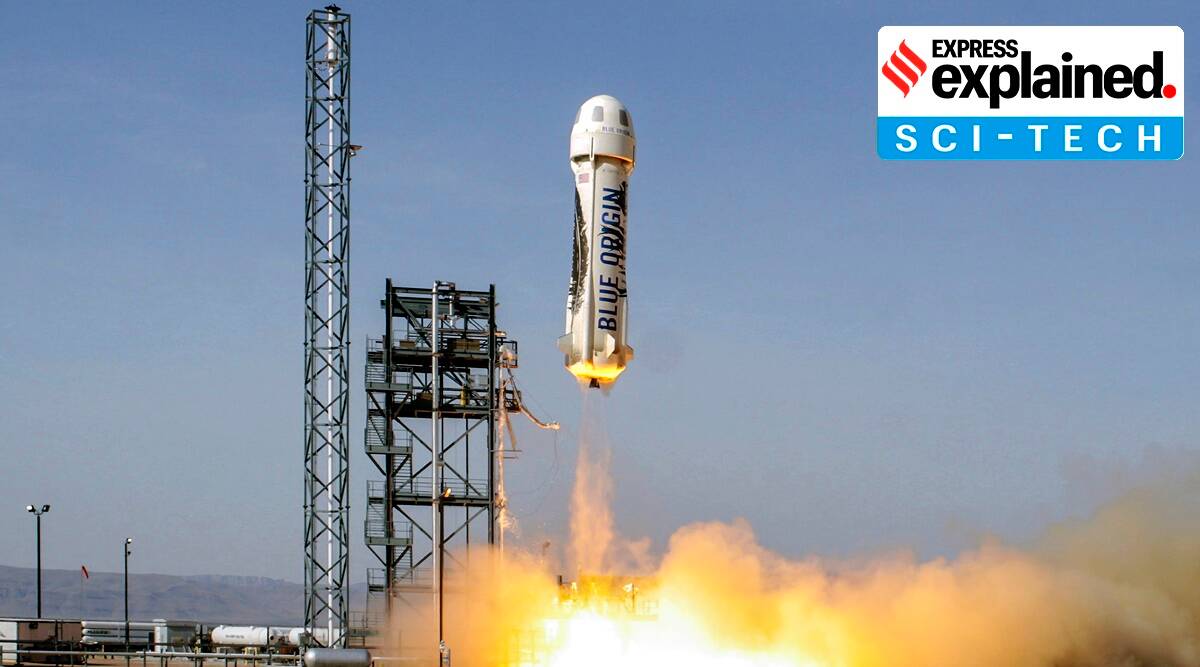
Explained: What is New Shephard, the rocket system designed to provide cost-effective access to space?
Last week, Amazon founder and billionaire Jeff Bezoss space companycalled Blue Origin concluded the online auction for the first seat on New Shephard, a rocket system meant to take tourists to space. Over 7,600 people registered from 159 countries to bid for this seat, which ultimately went for a winning bid of $28 million.The winning bidder will get to fly aboard New Shephard along with Bezos and his brother, when it takes its first human flight on July 20, which marks the 52nd anniversary of Neil Armstrong and Buzz Aldrins moon landing.Newsletter | Click to get the day’s best explainers in your inboxNew Shephard completed its seventh test launch successfully in October 2020 when it took off from Texas.In 2018, Blue Origin was one of the ten companies selected by NASA to conduct studies and advance technologies to collect, process and use space-based resources for missions to the Moon and Mars. In 2019, both signed an agreement that gives Blue Origin permission to use NASAs historic test stand, as a part of a growing number of partnerships between the space agency and the commercial space industry.What is New Shephard?New Shephard has been named after astronaut Alan Shephard – the first American to go to space – and offers flights to space over 100 km above the Earth and accommodation for payloads. Essentially, it is a rocket system that has been designed to take astronauts and research payloads past the Karman line the internationally recognized boundary of space. The idea is to provide easier and more cost-effective access to space meant for purposes such as academic research, corporate technology development and entrepreneurial ventures among others.Apart from its academic and research-oriented goal, New Shephard will also allow space tourists to experience microgravity by taking them 100 km above the Earth. Jeff Bezos, founder of Blue Origin, inspects New Shepards West Texas launch facility before the rockets maiden voyage. (Blue Origin website)Space tourismSpace tourism seeks to give laypeople the ability to go to space for recreational, leisure or business purposes. The idea is to make space more accessible to those individuals who are not astronauts and want to go to space for non-scientific purposes.A report published by the Congressional Research Service (CRS) notes that the concept of space tourism is fairly new. The report mentions that in 1997, the private company Space Adventures was founded to offer bookable space-related adventures.In fact, Space Adventures is the only private company to send paying customers to orbital space so far, the report says. In 2004, test pilot Mike Melville became the first private astronaut to fly beyond the Karman Line. which is recognised as the edge of space.In 2008, the billionaire video game developer, Richard Garriott became the sixth private citizen to fly to space. As per media reports, Garriott paid over $30 million to spend about 12 days at the ISS, which he traveled aboard a Russian Soyuz spacecraft.Before Garriott, Space Adventures customer Dennis Tito became the first space tourist in 2001. His flight to space was objected to by NASA citing lack of training. As per CRS, the company has sent seven paying customers to space between 2001 and 2009 and tourist visits to space came to halt in 2011, when NASA suspended its shuttle program, after which American astronauts were given seats on the Russian Soyuz spacecraft to get to the ISS.Apart from Blue Origin, Richard Bransons Virgin Galactic is also expected to begin space flights meant for space tourists this year. Elon Musks SpaceX is also working on sending tourists to space.How does it work?The rocket system consists of two parts, the cabin or capsule and the rocket or the booster.The cabin can accommodate experiments from small Mini Payloads up to 100 kg. As per Blue Origin, the Mini Payloads provide easier space access to students, who are part of educational institutions that are developing their own space programs, for less than the price of new football uniforms.Further, the cabin is designed for six people and sits atop a 60 feet tall rocket and separates from it before crossing the Karman line, after which both vehicles fall back to the Earth. All the six seats in the capsule are meant for passengers, each of whom get their own window seat. The capsule is fully autonomous and does not require a pilot.The system is a fully reusable, vertical takeoff and vertical landing space vehicle that accelerates for about 2.5 minutes before the engine cuts off.After separating from the booster, the capsule free falls in space, while the booster performs an autonomously controlled vertical landing back to Earth. The capsule, on the other hand, lands back with the help of parachutes.
……Read full article on The Indian Express
America Space
Comments
Leave a comment in Nestia App